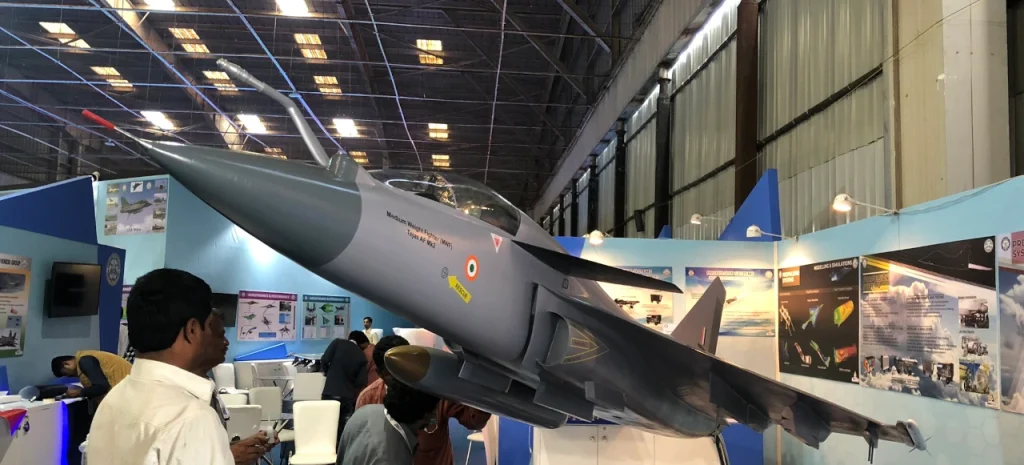Hindustan Aeronautics Limited (HAL) has just been granted authorization to begin production of the LCA Mk 2. HAL must now construct many Jigs, fixtures, and other production aids. Initially, the government desired a private partnership to expedite production, but none stepped forward because of the high costs involved. Consequently, HAL must now organize its own Consortium and commence the procedure.
The first flight of the LCA Mk 2 is planned for 2023, and the first three prototypes are to be delivered by 2024. But this may be now delayed.
In September, the government’s Cabinet Committee on Security (CCS) authorized the project’s development, flight testing, and certification.
LCA Mk 2
At Aero India 2019, the Indian Aviation Development Agency ADA (Aeronautical Development Agency) displayed a model of a medium fighter (MWF) co-developed with HAL and called Tejas Mk.2 MWF (Medium Weight Fighter). The Tejas Mk 2 is scheduled to be delivered to the Indian Air Force (IAF) to fill the void in medium multirole fighters and replace the Mirage-2000 already in service.
The Tejas Mk.2 MWF is an improved variant of the Tejas light combat aircraft (LCA). The upgrade involves an increase in length to 14.6 m and an increase in wingspan to 8.5 m (for LCA 13 and 8.2 m, respectively) to boost the payload-carrying capacity. The aircraft is equipped with a delta wing and two nose rudders (canards), which cut drag at almost all angles of attack.
As per ADA, the aircraft’s maximum takeoff weight will be 17.5 tonnes, while the payload will be 6.5 tonnes. The fighter will be outfitted with a more powerful GE-F414-INS6 engine with electronically controlled operating modes created by General Electric (FADEC). In addition, Tejas Mk.2 will be equipped with an infrared target search and tracking system (IRST), a missile attack warning system (MAWS), and an electronically scanned active array antenna array (AESA) radar. The aircraft is armed with long-range missiles and heavy precision-guided bombs (PGM).

Since 2011, ADA has shown various models of a modified LCA. The last known design was frozen in 2018. According to the agency spokesman, the developers gained “important expertise” from the Tejas Mk.1 / 1A programme and are on track to fulfil the Tejas Mk.2 MWF development plan. According to ADA plans, the Tejas Mk.2 MWF’s flight testing is expected to commence in 2023, and its implementation is slated for 2024-2025. Speaking about the delay in the final technical approval of the aircraft, the ADA representative acknowledged that the Air Force command’s frequent changes to its requirements significantly delay the process. However, ADA is confident that the model displayed at Aero India 2019 meets all of the Air Force’s requirements for a medium-sized fighter.
To equip the LCA Tejas Mk.II, an airborne radar with a 100 km airborne target detection range will be provided. A preliminary calibration of a prototype fitted with an antenna sheet (Active Aperture Array Antenna Unit – AAAU) and domestically designed transceiver modules (TPM) has been accomplished, according to reports. The processor and air-to-air signal receiver were evaluated on high-altitude platforms as part of radar with mechanical beam scanning. The subsequent stage will include testing components in the air-to-surface mode with high resolution of the earth’s surface, identifying multiple moving targets, and executing electronic warfare duties. Although AFAR development is not yet complete, the DRDO is banking on Israeli support. Radar development started in 2011-2012.
LCA Mk1 vs LCA Mk II
The Mk2 variant will offer major benefits over the Mk1 version currently used by the Indian Air Force. In all likelihood, the new aircraft prototype will take to the skies by the end of 2023. The primary needs of the Air Force are expanded range and the capacity to use the most advanced weapons. The maximum takeoff weight will rise from 13,500 kg to 17,500 kg, and the length of the aircraft will expand by 1.35 metres. The Mk2 will be able to carry additional external fuel tanks due to the larger fuselage, which will allow for more fuel to be stored behind the cockpit. The added length altered the centre of gravity of the fighter, requiring the development of a “front lifting surface.” It was said that the ADA had determined that a PGO would improve manoeuvrability after examining a variety of possibilities, including greater inflow.
Additionally, the delta wing design of the new aircraft will be improved. According to one report, the tail unit aids in other flying stages. In addition, four modified General Electric F414-INS6 engines have already been delivered. Tejas Mk1 and Mk1A have the less powerful F404 engine. The Mk2 variation will be able to bear external weights of up to 6.5 tonnes, compared to the original model’s 3.3 tonnes. The new fighter will include new underwing pylons for air-to-air missiles and two cheek pylons (under the air intakes) for mounting weapons or sensors. To distinguish the Mk2 from the Mk1, the firm refers to it as a “Medium Weight Fighter” (MWF), while the Mk1 is regarded as a “Light Combat Aircraft” (LCA). The Mk2 additionally has an IR sensor (IRST).
LCA Mk2 orders
ACM Chaudhari has said that the IAF would want to equip six squadrons with Mk 2 aircraft. At 18 aircraft per squadron, the IAF needs 108 jets. The numbers may go up depending on the situation in the future.
